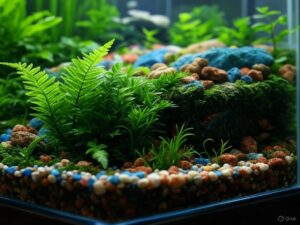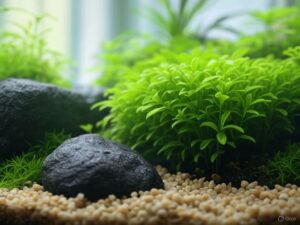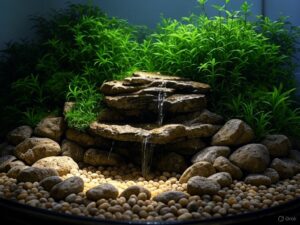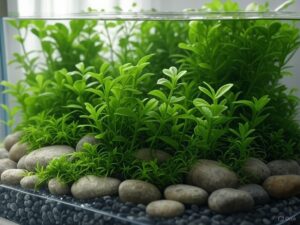Master Aquascaping: Essential Strategies to Correct Common Mistakes
Aquascaping for Beginners: Picture a stunning, miniature underwater forest where vibrant plants, intriguing rocks, and shimmering water create an enchanting scene. Aquascaping is an artistic endeavor that transforms an ordinary aquarium into a breathtaking aquatic masterpiece, seamlessly blending artistic flair with scientific principles to create a visual feast. This rewarding hobby not only elevates the atmosphere in your home or workspace but also nurtures a peaceful ambiance that can calm the mind and spirit. Equipped with the right skills and insights, anyone can design an awe-inspiring aquascape that captivates attention and sparks joy in viewers.
Your aquascaping journey starts with choosing the right tank size, a decision that holds considerable weight in your overall success. Selecting a tank that is too small may limit your creative vision and make it difficult to achieve a balanced aesthetic. On the other hand, opting for an excessively large tank can result in daunting maintenance challenges. Carefully assess your available space and visualize how the tank will fit into your room's decor, ensuring it enhances the existing style while creating a serene and inviting atmosphere.
Having a well-defined vision for your desired aquascape setup is crucial for making informed choices. Do you want to create a striking focal point or a serene, low-maintenance environment? This concept will guide you in selecting suitable plants, rocks, and fish that align with your objectives. Evaluate the beauty and function of each component, ensuring they harmonize to achieve your ultimate design goal.
For those venturing into aquascaping for the first time, starting with simpler designs is highly recommended. While intricate layouts can be visually captivating, they often present significant challenges for novices. Take the time to understand the basics, including how diverse plants and rocks interact, before attempting more complex designs. Mastering foundational techniques will provide you with the confidence necessary to unleash your creativity in future projects.
Grasping the fundamental principles of aquascaping is vital for steering clear of common mistakes. With careful planning and a bit of creativity, you can elevate any ordinary aquarium into a mesmerizing work of art that enchants viewers and enriches your living space.

Eliminate Common Errors in Substrate Selection and Aquascape Layout
The term “substrate” refers to the foundational material that forms the base layer of your aquarium, and while it may seem technical, it plays a pivotal role in the success of your aquascape.
Think of the substrate as the bedrock of your aquatic paradise; it significantly influences the health of your plants, their growth patterns, and the overall aesthetics of your aquarium. Choosing the right substrate can dramatically enhance plant vitality and the cohesion of your ecosystem.
Selecting an inappropriate substrate can disrupt the equilibrium of your entire aquascaping design. Have you ever noticed an aquarium that feels cluttered or chaotic? Often, the root cause lies in poor substrate choices. Opt for nutrient-rich substrates that provide essential nourishment for plant growth, similar to offering your plants a diet rich in superfoods to flourish.
When choosing your substrate, resist the impulse to select based solely on visual appeal. While a substrate may look attractive, if it fails to meet the biological needs of your plants, you’ll end up with a superficially pleasing yet ineffective aquarium. Consider layering different substrate types to achieve a visually stunning yet functional base for your aquascape.
Regarding layout, while a seemingly random placement of elements might appear visually dynamic, it can often lead to a disorganized look within the tank.
Design your aquascape with intention and purpose. Create a clear plan for how each component will be arranged, and stick to it for a polished and cohesive appearance. A well-structured layout not only boosts visual appeal but also fosters overall harmony and balance within your aquarium.
Remember, perspective plays a crucial role in aquascaping. Avoid crafting a tank that seems flat or one-dimensional. By incorporating varying heights and depths with rocks, driftwood, and plants, you can create a more dynamic and realistic environment that invites viewers in and inspires wonder.
Be vigilant, as the arrangement of your aquascape can profoundly impact its success or failure.

Deliberate Plant Selection and Effective Maintenance for a Thriving Aquatic Ecosystem
Choosing the right plants for your aquascape transcends mere aesthetics; it's akin to designing a balanced mini-garden where each species must enhance the others' growth. The objective is to ensure that the plants coexist harmoniously rather than competing for space or light, thus fostering a cohesive and flourishing ecosystem.
When embarking on your aquascaping journey, the myriad of available plant species can be daunting. It's easy to become overly enthusiastic and overcrowd your tank, resulting in a chaotic, jungle-like atmosphere. Remember, allowing adequate space for each plant enables them to thrive individually while promoting a healthier aquatic ecosystem. Space becomes your ally in cultivating a balanced and thriving habitat.
Lighting is another critical factor influencing your plants’ health. Just as in a terrestrial garden, different aquatic plants have unique light requirements. Excessive light can cause some plants to bleach, while insufficient light can stunt their growth. Conduct thorough research into the specific needs of each plant before establishing your lighting system. This investment in knowledge can save you from future headaches and complications.
Although the term maintenance may elicit groans, it is essential for preserving the health and vibrancy of your plants. Regular pruning not only helps manage growth but also enhances the overall aesthetics of your tank. Even a small trim can significantly improve the appearance of your aquascape.
Stay alert for signs of plant distress. Yellowing leaves or stunted growth may signal underlying issues related to nutrients or light levels. Additionally, pests can pose a serious threat to your plants. If you encounter unwanted visitors feasting on your greenery, it is crucial to address the situation promptly to prevent larger infestations that could jeopardize the health of your aquatic plants.

Fostering a Balanced Aquascape Ecosystem: Ensuring Fish and Plant Compatibility
Establishing a balanced ecosystem within your aquascape is like hosting a well-organized dinner party where all guests coexist harmoniously. Your choice of fish is critical, not only for the visual allure of the tank but also for creating an environment that supports both fish and plant life.
Some fish species thrive alongside specific plant types, while others may pose a threat by consuming them.
Understanding which fish species can coexist peacefully with your aquatic plants is essential to prevent chaos in your aquarium. Invest time in researching common fish companions for aquascapes, such as tetras and barbs, which introduce dynamic movement and vibrant hues without disturbing the plant life.
Consider enhancing your aquascape by creating a comfortable habitat for your fish. Adding rocks and driftwood can provide essential hiding places that help reduce stress for both fish and plants. These small shelters can serve as refuge areas, fostering a calm and natural atmosphere within your aquatic ecosystem.
To maintain balance, ensure you allocate space for free-swimming fish while preventing plants from overcrowding the tank. This thoughtful arrangement leads to a healthier and happier aquarium ecosystem, benefitting both fish and aquatic plants.
When designing your aquatic landscape, keep in mind that aesthetics and functionality must go hand in hand. An effective aquascape should address both visual appeal and the practical needs of your ecosystem, resulting in a flourishing aquatic environment.
Regular monitoring for invasive species is vital to sustaining a harmonious ecosystem.
While some newcomers may seem harmless initially, they can quickly disrupt the equilibrium of your aquascape if left unchecked. To ensure a thriving environment, it’s crucial to keep any new additions aligned with your design and the specific requirements of your existing setup.

Crucial Equipment for Successful Aquascaping: What You Need to Know
Creating a thriving aquarium is not solely reliant on plants and fish; your equipment serves as the unsung hero of your aquascaping journey. Recognizing the importance of suitable gear is essential, as lacking the right tools can lead to disaster rather than a flourishing aquascape.
Begin with a dependable filtration system. This vital equipment acts like an air conditioner on a scorching summer day, maintaining a clean and balanced environment. A high-quality filter will keep the water crystal clear and free from harmful substances, ensuring a stable habitat for both your plants and fish.
Next, consider your lighting requirements. Think of lighting as the sun for your tank; selecting the wrong type or intensity can hinder your plants’ ability to photosynthesize effectively. Opt for LED lights that mimic natural sunlight, as they are energy-efficient and promote healthy plant growth.
Water quality is another critical factor impacting your aquarium’s health. Regularly testing pH, nitrate, and ammonia levels is as crucial as watering a terrestrial garden. Conducting simple tests can avert major issues down the line, ensuring your aquarium remains a suitable environment for its inhabitants.
Oxygen and CO2 levels are crucial yet often overlooked factors. If you notice your fish gasping at the surface or observe your plants turning brown, it may signal an imbalance in these vital gases. Consider using CO2 injectors to enhance plant growth, especially in densely planted aquascapes.
Finally, maintaining a consistent water temperature is essential for the well-being of your aquatic life. Depending on the species in your tank, ensuring stable water temperature is key. Investing in heaters or chillers can help create the ideal environment for your aquatic inhabitants to prosper.
The Article : Aquascaping for Beginners Appeared First On Unity Pets.
The Article Aquascaping Basics: A Beginner’s Guide Was Found On https://limitsofstrategy.com


Your exploration of aquascaping as a blend of art and science truly resonates with the transformative power this hobby can have on our environment and well-being. Personally, I’ve found that aquascaping goes beyond just creating a pleasing aesthetic; it becomes a meditative practice that allows for self-expression and connection with nature.
You’ve touched on something really important—the meditative aspect of aquascaping, which often gets overlooked when people think about the hobby simply as planting or decorating a tank. The way you describe it as a form of self-expression and a connection with nature resonates with many enthusiasts. It’s more than just mechanics; it’s about creating a miniature world that reflects both our inner selves and the natural beauty of the ecosystems we’re trying to replicate.
You’ve really hit the nail on the head! It’s easy to think of aquascaping as just sticking some plants in a tank and calling it a day. But you’re right—it’s almost like therapy, isn’t it? I mean, here we are, knee-deep in water, rearranging rocks, and trying not to flood the living room. Talk about a zen moment.
It’s interesting how aquascaping blends art and science in such a unique way. The transformative power it has on our environment and well-being is something I’ve felt deeply as well. When I create a new aquascape, I often find it to be an exploration of balance—not just between the elements of the tank but within myself.
You’ve touched on an important aspect of aquascaping that often goes unspoken. The way it blends art and science creates a unique canvas for self-exploration and personal balance. When you dive into creating a new aquascape, you’re not just arranging plants and rocks; you’re contemplating their relationships to each other and to the overall ecosystem. It’s like a tiny universe that reflects larger truths about balance in life.
“I’m glad to hear that you resonate with the balance of art and science in aquascaping! If you’re looking for inspiration or resources to further your exploration, check out this [link](#) for some great ideas and tips.”
https://electroquench.com/consult
I completely agree with you on how aquascaping serves as a microcosm for exploring balance and relationships. It’s fascinating to see how every plant and rock plays a role, not just in aesthetics but in fostering a healthy ecosystem. When I dive into a new layout, I often find myself reflecting on those dynamics—how the positioning of elements can create harmony or tension, much like in our own lives.
You’ve hit on something really interesting. That idea of every element having a role is key in aquascaping, just like in life. It’s wild how a tiny adjustment—a plant moved here, a stone shifted there—can change the whole vibe of the tank. It reminds me that sometimes, in our own lives, what might seem like a small change can really create a ripple effect.
“I’m glad you resonated with those insights! If you’re interested in exploring more about the art and philosophy of aquascaping, check out this resource that delves deeper into creating those harmonious ecosystems.”
https://electroquench.com/ParentAler
It’s great to hear your thoughts on aquascaping—it really does feel like a dance between art and science, doesn’t it? The process of creating an aquascape is such a personal journey. Each choice—from the type of plants to the arrangement of rocks—becomes a reflection of our inner landscape.
“I’m so glad to hear that you resonate with the balance of aquascaping! If you’re looking to deepen your exploration and find inspiration for your next project, check out this resource that beautifully merges creativity and technique.”
https://electroquench.com/emailoctopus
You’ve captured a really profound aspect of aquascaping. The way it intertwines art and science creates a space that’s not just visually appealing, but also deeply reflective. When we think about the delicate balance between the natural elements—like plants, substrates, and hardscape materials—a parallel can often be drawn to our internal landscapes.
You’ve touched on something really meaningful in your observation. The interplay of art and science in aquascaping certainly reflects our own complexities. Each element serves not just a purpose, but also a narrative, much like our thoughts and emotions.
I really appreciate your perspective on aquascaping as an intersection of art and science. It’s fascinating how the act of arranging water, plants, and rocks can invoke such a deeper reflection on balance—not just the aesthetic harmony within the tank but also the internal equilibrium we strive for in our lives.
You’ve hit on something pretty cool there. Aquascaping is like a zen garden but with fish – and, let’s be honest, less raking. It’s all about finding that sweet spot where every rock and plant feels like it belongs, much like trying to get your life in order when you realize that your laundry basket has become its own ecosystem.
The way you describe aquascaping as a meditative practice really captures its essence. There’s something uniquely grounding about the process, isn’t there? When you immerse yourself in the careful arrangement of plants, stones, and water, it becomes more than just a task; it turns into a conversation with nature. The act of designing a living landscape allows us to reflect, breathe, and connect with the rhythms of life unfolding before us.
“I’m glad to hear you share that perspective! If you’re interested in exploring more about the art of aquascaping and how it can enhance your space and well-being, check out this link for some inspiring resources.”
https://electroquench.com/ChocolateHealth
I completely resonate with what you’ve shared about aquascaping as a meditative practice. There’s something truly special about being fully present in the process— arranging the rocks just so, placing each plant with intention. It’s like a gentle reminder of the balance and beauty in nature, which often gets overshadowed in our fast-paced lives.
You’ve captured something essential about aquascaping—the way it calls us to be mindful and really engage with our surroundings. When we take the time to arrange rocks and position plants, it’s as if we’re entering a dialogue with nature itself. Each decision becomes a reflection of our mood and a response to the elements within the tank. It’s fascinating how this careful placement can echo broader life lessons about balance and harmony.
“I’m glad to hear that! If you’re looking for some inspiration or resources to enhance your aquascaping journey, check out this link—it’s filled with tips to help deepen that peaceful connection with nature.”
https://electroquench.com/ChocolateHealth